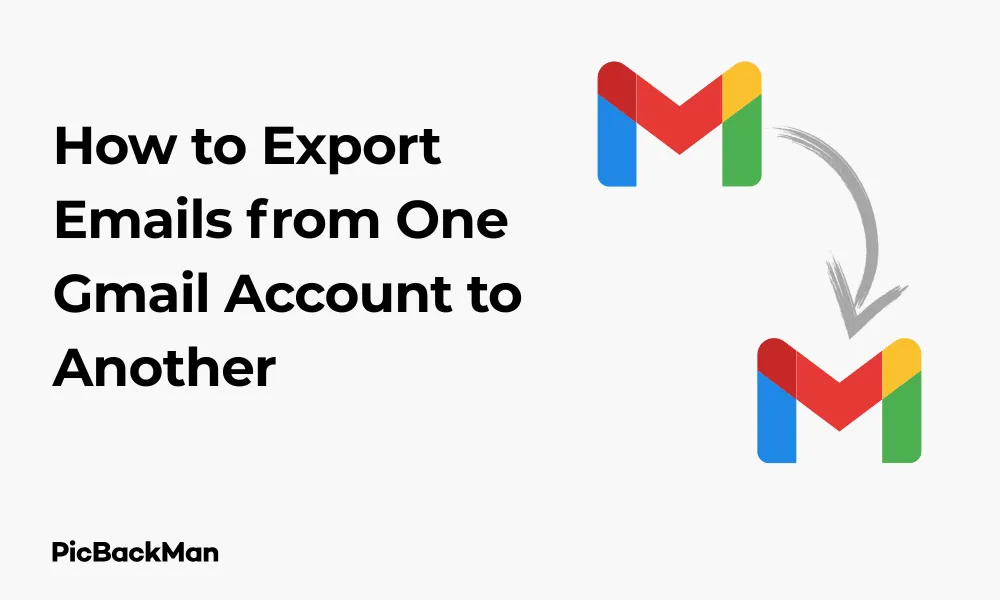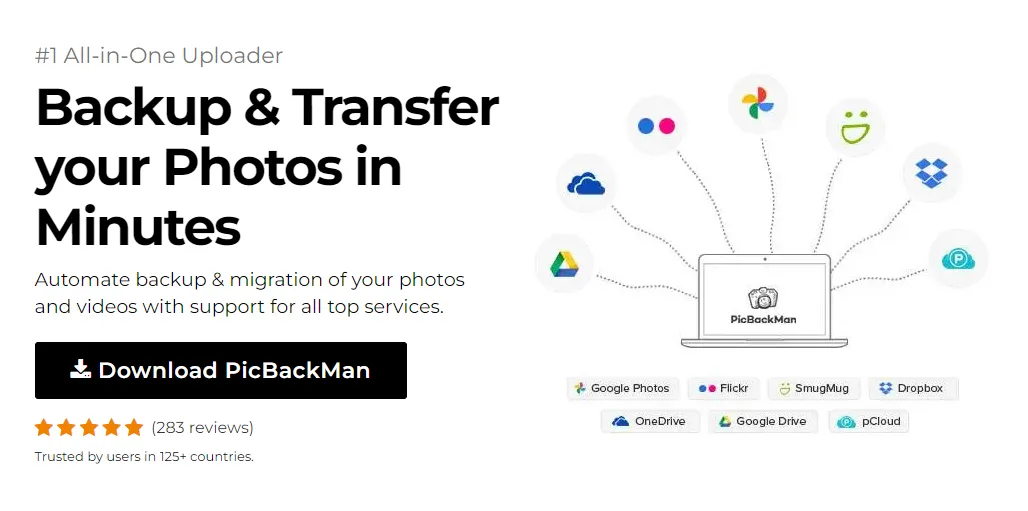
Why is it the #1 bulk uploader?
- Insanely fast!
- Maintains folder structure.
- 100% automated upload.
- Supports RAW files.
- Privacy default.
How can you get started?
Download PicBackMan and start free, then upgrade to annual or lifetime plan as per your needs. Join 100,000+ users who trust PicBackMan for keeping their precious memories safe in multiple online accounts.
“Your pictures are scattered. PicBackMan helps you bring order to your digital memories.”
How to Export Emails from One Gmail Account to Another - Top 5 Ways


Need to move your emails from one Gmail account to another? Whether you're switching jobs, creating a new personal account, or just organizing your digital life, transferring emails between Gmail accounts is a common task that many people struggle with. The good news is that Google provides several methods to make this process straightforward.
In this guide, I'll walk you through the top 5 ways to export emails from one Gmail account to another, with step-by-step instructions for each method. By the end of this article, you'll be able to choose the approach that works best for your specific situation.
Method 1: Using Gmail's POP3/IMAP Settings
One of the most reliable ways to export emails from one Gmail account to another is by using Gmail's built-in POP3/IMAP settings. This method allows you to pull emails from your old account directly into your new one.
Step-by-Step Instructions:
- Enable POP in your old Gmail account:
- Sign in to your old Gmail account
- Click the gear icon in the top right corner and select "See all settings"
- Go to the "Forwarding and POP/IMAP" tab
- In the "POP download" section, select "Enable POP for all mail"
- Choose "Keep Gmail's copy in the Inbox" in the dropdown menu
- Click "Save Changes" at the bottom of the page
- Set up your new Gmail account to import emails:
- Sign in to your new Gmail account
- Click the gear icon and select "See all settings"
- Go to the “Accounts and Import” tab
- In the "Check mail from other accounts" section, click "Add a mail account"
- Enter your old Gmail email address and click "Next"
- Select "Import emails from my other account (POP3)" and click "Next"
- Enter your old Gmail password
- POP Server: pop.gmail.com, Port: 995
- Check "Leave a copy of retrieved message on the server"
- Check "Always use a secure connection (SSL) when retrieving mail"
- Choose whether to label incoming messages or archive them
- Click "Add Account"
Gmail will now start importing emails from your old account to your new one. Depending on how many emails you have, this process could take several hours or even days.
Pros of Using POP3/IMAP:
- No third-party tools required
- Works directly within Gmail
- Can be set up to continuously import new emails
Cons of Using POP3/IMAP:
- Slower for large email collections
- May not preserve all labels/folders structure
- Limited to 15,000 emails per day
Method 2: Using Google Takeout for Email Export/Import
Google Takeout is Google's data export service that allows you to download data from your Google Account, including all your Gmail messages. This method is particularly useful when you need to transfer a large number of emails at once.
Step-by-Step Instructions:
- Export emails from your old Gmail account:
- Go to Google Takeout
- Sign in with your old Gmail account
- Deselect all products by clicking "Deselect all"
- Scroll down and select only "Mail"
- Click "Next step"
- Choose your delivery method (typically "Send download link via email")
- Select your file type and size (ZIP is recommended)
- Click "Create export"
- Wait for the export to complete:
- Google will send you an email when your export is ready
- This may take hours or days depending on the size of your mailbox
- Download the ZIP file(s) containing your emails when ready
- Import emails to your new Gmail account:
- Sign in to your new Gmail account
- Click the gear icon and select "See all settings"
- Go to the “Accounts and Import” tab
- In the "Import mail and contacts" section, click "Import mail and contacts"
- Enter your old Gmail address and click "Continue"
- Sign in to your old account when prompted
- Select what you want to import (emails, contacts, etc.)
- Click "Start import"
Pros of Using Google Takeout:
- Can handle very large email collections
- Creates a backup of your emails
- Preserves more metadata than other methods
Cons of Using Google Takeout:
- The process can be time-consuming
- Requires downloading potentially large files
- More complex than other methods
Method 3: Using Email Forwarding
Email forwarding is a simple way to ensure that all new emails sent to your old account are automatically sent to your new account. While this doesn't transfer existing emails, it's a good complementary method to use alongside other approaches.
Step-by-Step Instructions:
- Set up forwarding in your old Gmail account:
- Sign in to your old Gmail account
- Click the gear icon and select "See all settings"
- Go to the "Forwarding and POP/IMAP" tab
- In the "Forwarding" section, click "Add a forwarding address"
- Enter your new Gmail address and click "Next"
- A verification email will be sent to your new Gmail account
- Open your new Gmail account and click the verification link in the email
- Complete the forwarding setup:
- Return to your old Gmail account's settings
- Refresh the page if needed
- Select "Forward a copy of incoming mail to"
- Choose what to do with the original message (keep it, archive it, or delete it)
- Click "Save Changes" at the bottom of the page
Pros of Using Email Forwarding:
- Simple to set up
- Ensures you don't miss new emails during the transition
- No third-party tools required
Cons of Using Email Forwarding:
- Only forwards new emails, not existing ones
- May not preserve email labels or categories
- Requires keeping both accounts active
Method 4: Using the Gmail to Gmail Migration Tool
Gmail has a built-in migration tool specifically designed for transferring emails from one Gmail account to another. This method is straightforward and handles both emails and contacts.
Step-by-Step Instructions:
- Access the migration tool:
- Sign in to your new Gmail account
- Click the gear icon and select "See all settings"
- Go to the “Accounts and Import” tab
- Find the "Import mail and contacts" section
- Click "Import mail and contacts"
- Set up the import:
- Enter your old Gmail email address in the pop-up window
- Click "Continue"
- A new window will open asking you to sign in to your old account
- Sign in with your old Gmail credentials
- Allow the required permissions when prompted
- Choose what to import:
- Select which items you want to import (emails, contacts, etc.)
- Choose whether to import for 30 days or all emails
- Decide if you want to add a label to imported messages
- Click "Start import"
- Monitor the import process:
- The import will begin immediately
- You can check the status under "Import mail and contacts"
- The process may take several hours or days depending on volume
- You can continue using Gmail while the import runs
Pros of Using the Gmail Migration Tool:
- User-friendly interface
- Imports contacts along with emails
- Option to label imported messages
Cons of Using the Gmail Migration Tool:
- Limited to 30 days of emails in some cases
- May not preserve all folder structures
- Can be slow for large mailboxes
Method 5: Using Third-Party Email Migration Tools
If the built-in Google methods don't meet your needs, several third-party tools can help transfer emails between Gmail accounts. These tools often offer additional features and flexibility.
Popular Third-Party Email Migration Tools:
| Tool Name | Key Features | Cost | Best For |
|---|---|---|---|
| Shift | Manages multiple email accounts, preserves folders | Free basic version, paid plans start at $99.99/year | Users who manage multiple email accounts regularly |
| YippieMove | Specialized email migration service | $15 per migration | One-time migrations with minimal setup |
| MultCloud | Cloud-to-cloud transfer, scheduled transfers | Free basic version, premium from $9.90/month | Moving data between multiple cloud services |
| Backupify | Comprehensive backup and migration | Contact for pricing | Business users with large data volumes |
| CloudHQ | Real-time sync, preserves folder structure | Free basic version, premium from $118.80/year | Ongoing synchronization between accounts |
Using CloudHQ as an Example:
- Set up your CloudHQ account:
- Go to the CloudHQ website and sign up for an account
- Choose the free plan or select a premium option
- Complete the registration process
- Connect your Gmail accounts:
- In the CloudHQ dashboard, click "Add New Sync"
- Select "Gmail" as the source
- Sign in to your old Gmail account when prompted
- Select "Gmail" as the destination
- Sign in to your new Gmail account
- Configure your sync settings:
- Choose which folders/labels to sync
- Select your sync direction (one-way or two-way)
- Set up filters if needed
- Choose whether to sync deletions
- Set up a sync schedule if desired
- Start the migration:
- Review your settings
- Click "Save and Run Now"
- Monitor the progress in the CloudHQ dashboard
Pros of Using Third-Party Tools:
- Often more feature-rich than built-in options
- Better preservation of folder structures and labels
- May offer scheduling and filtering options
Cons of Using Third-Party Tools:
- May require payment for full functionality
- Requires giving access to your email accounts
- Varying levels of technical support
Quick Tip to ensure your videos never go missing
Videos are precious memories and all of us never want to lose them to hard disk crashes or missing drives. PicBackMan is the easiest and simplest way to keep your videos safely backed up in one or more online accounts.
Simply download PicBackMan (it's free!) , register your account, connect to your online store and tell PicBackMan where your videos are - PicBackMan does the rest, automatically. It bulk uploads all videos and keeps looking for new ones and uploads those too. You don't have to ever touch it.
Comparison of Email Export Methods
| Method | Ease of Use | Speed | Preserves Structure | Cost | Best For |
|---|---|---|---|---|---|
| POP3/IMAP | Medium | Slow | Partial | Free | Smaller email collections |
| Google Takeout | Medium | Slow | Good | Free | Complete backups and large transfers |
| Email Forwarding | Easy | N/A (future emails only) | Poor | Free | Transitioning to a new account gradually |
| Gmail Migration Tool | Easy | Medium | Good | Free | Simple Gmail-to-Gmail transfers |
| Third-Party Tools | Varies | Fast | Excellent | Free to $$$ | Complex migrations with specific requirements |
Tips for a Successful Email Migration
Before You Start
- Clean up your old email account by deleting unnecessary emails and emptying trash
- Organize important emails into folders or with labels to make them easier to find after migration
- Make sure both Gmail accounts have sufficient storage space
- Check your internet connection - a stable connection is important for large transfers
- Set aside enough time for the migration to complete
During the Migration
- Don't close your browser or put your computer to sleep during critical migration steps
- If using POP3, be aware that it may take several days to complete for large mailboxes
- For large migrations, consider breaking them into smaller batches by using labels
- Monitor the process periodically to ensure its progress
After the Migration
- Verify that important emails transferred correctly by checking samples
- Set up email forwarding from your old account to catch any new messages
- Update your email address with important contacts and services
- Keep your old account active for a while to ensure you don't miss anything
Troubleshooting Common Issues
Migration Process Stops or Fails
- Check your internet connection and try again
- Ensure you have sufficient storage in your new Gmail account
- If using Google Takeout, try requesting a smaller export by fewer selecting labels
- For POP3 issues, verify your settings and password are correct
- Try breaking the migration into smaller batches
Missing Emails After Migration
- Check the spam or trash folders in your new account
- Look for emails under the "All Mail" label
- Verify if filters in your new account may be affecting incoming mail
- Check if emails were imported with a specific label
Labels or Folders Not Preserved
- Some methods (especially POP3) don't preserve label structures
- Consider using Google Takeout or third-party tools for better structure preservation
- Manually recreate important labels in your new account
Authentication Problems
- Ensure you're using the correct password
- Check if you need to allow less secure apps in your Google account settings
- Try generating an app password if you use 2-factor authentication
- Clear your browser cache and cookies, then try again
Conclusion
Exporting emails from one Gmail account to another doesn't have to be complicated. Each of the five methods we've covered has its strengths and is suitable for different situations. For smaller email collections or ongoing transfers, the built-in Gmail tools like POP3/IMAP or the Gmail Migration Tool work well. For larger migrations or when you need to preserve your folder structure, Google Takeout or third-party tools might be better options.
Remember to plan your migration carefully, clean up your old account beforehand, and verify that everything transferred correctly afterwards. By following the steps outlined in this guide, you'll be able to move your emails smoothly and keep all your important communications accessible in your new Gmail account.
Whether you're changing jobs, consolidating accounts, or just getting a fresh start with a new email address, these methods will help you bring your email history along with you.
Frequently Asked Questions
1. How long does it take to transfer emails from one Gmail account to another?
The time required depends on the method you choose and the number of emails you're transferring. For small accounts (a few hundred emails), it might take just a few hours. For larger accounts with thousands of emails, expect the process to take several days, especially if using POP3/IMAP or Google Takeout.
2. Will my email attachments be transferred during the migration?
Yes, all the methods described in this article will transfer email attachments along with the email content. However, if you have very large attachments or a high volume of them, the migration might take longer to complete.
3. Can I transfer my Gmail contacts and calendar along with my emails?
Yes, but not all methods handle contacts and calendar data. The Gmail Migration Tool and Google Takeout both offer options to export contacts along with emails. For calendar data, you'll need to use Google Takeout or export your calendar separately through Google Calendar settings.
4. Is there a limit to how many emails I can transfer between Gmail accounts?
There are some limitations depending on the method. When using POP3, Gmail limits you to downloading about 15,000 messages per day. The Gmail Migration Tool may also have daily limits. Google Takeout and third-party tools generally don't have strict limits, but very large mailboxes (over 10GB) might require breaking the transfer into multiple operations.
5. Do I need technical skills to transfer emails between Gmail accounts?
Basic computer skills are sufficient for most of these methods. The Email Forwarding and Gmail Migration Tool options are the most user-friendly. POP3/IMAP and Google Takeout require following detailed instructions but aren't overly technical. Third-party tools vary in complexity, but many offer user-friendly interfaces designed for non-technical users.






